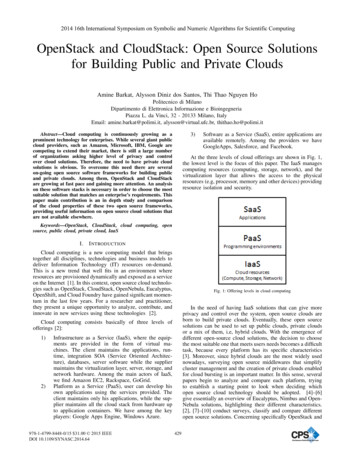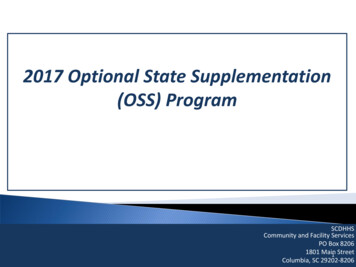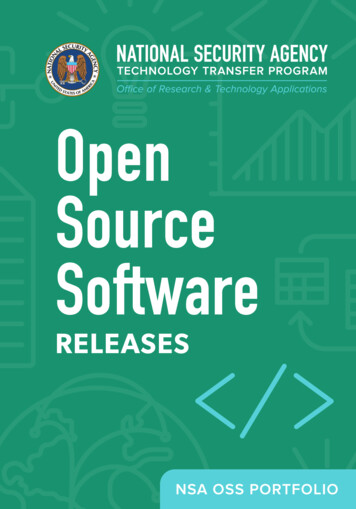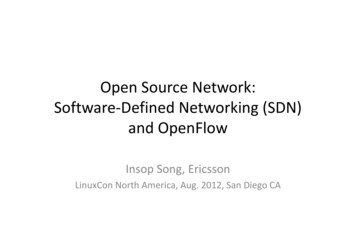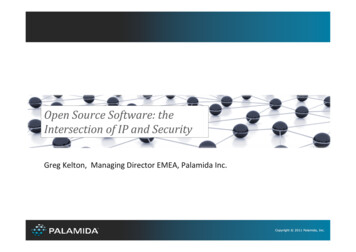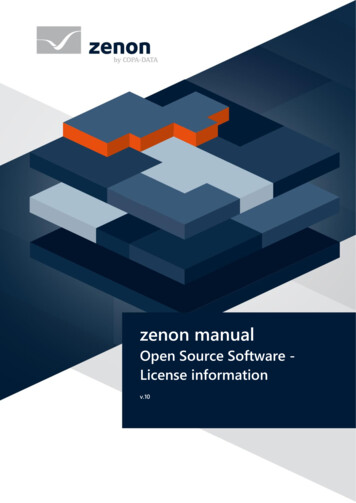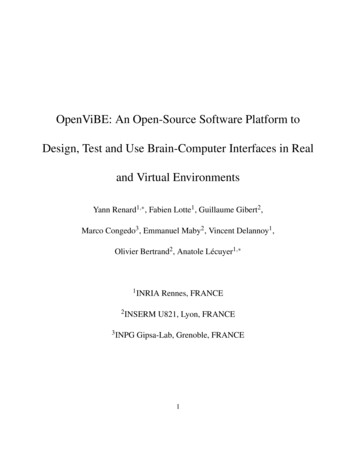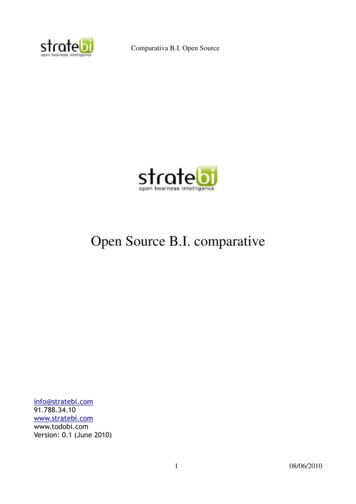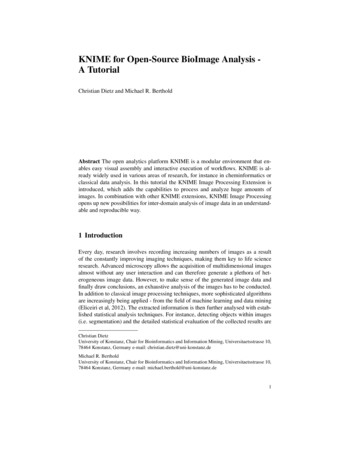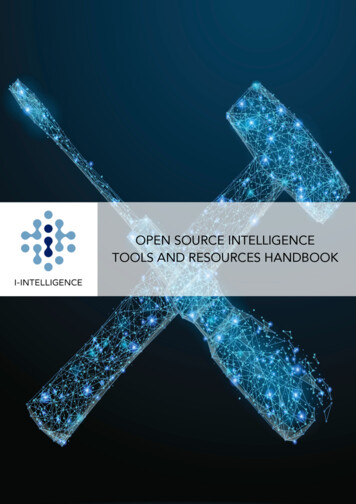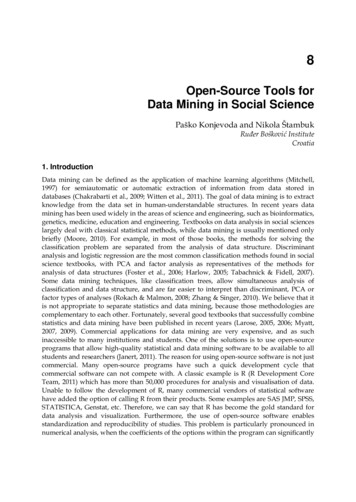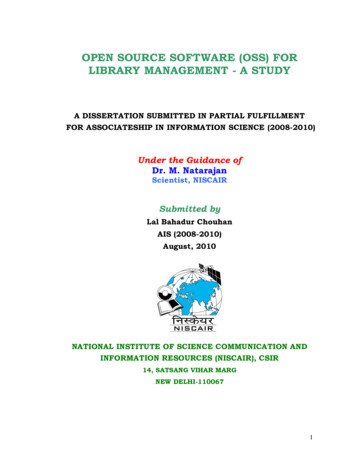
Transcription
OPEN SOURCE SOFTWARE (OSS) FORLIBRARY MANAGEMENT - A STUDYA DISSERTATION SUBMITTED IN PARTIAL FULFILLMENTFOR ASSOCIATESHIP IN INFORMATION SCIENCE (2008-2010)Under the Guidance ofDr. M. NatarajanScientist, NISCAIRSubmitted byLal Bahadur ChouhanAIS (2008-2010)August, 2010NATIONAL INSTITUTE OF SCIENCE COMMUNICATION ANDINFORMATION RESOURCES (NISCAIR), CSIR14, SATSANG VIHAR MARGNEW DELHI-1100671
CERTIFICATEThis is to certify that Mr. Lal Bahadur Chouhan, AIS Student (2008-2010)has prepared his dissertation entitled “Open Source Software (OSS) forLibrary Management - a Study” under my guidance for partial fulfillmentfor the award of Associateship in Information Science, a two year teofScienceCommunication and Information Resources (NISCAIR), CSIR, New Delhi,India.To the best of my knowledge the work is original and has not beensubmitted elsewhere.Dated:Dr. M. NatarajanScientist “F”ETD, NISCAIR, CSIR14, Satsang Vihar MargNew Delhi-1100672
ACKNOWLEDGEMENTThis dissertation could not have been completed without the support andguidance of a number of individuals and organizations. I would therefore,like to express my sincere gratitude to them. My supervisor, Dr. M.Natarajan, Scientist “F”, NISCAIR for his guidance and support enabled meto complete the dissertation in time. I would like to express my gratitude toMs. V. V. Laxmi, the then Coordinator SAARC Documentation Centre (SDC),and New Delhi.I would like to thank the following respected teachers’ Mrs. Renu Arora,Head- ETD and Faculty members Mr. G. Mahesh, Mr. Mukesh Pund, Mr.Salim Ansari and Dr. B. K. Sen, Dr. T. K. Jain, NISCAIR, New Delhi.I would like to express my gratitude to Mr. Krishna Mani Bhandary, ChiefLibrarian, Tribhuvan University Central Library who has given me anopportunity to study AIS Course, in NISCAIR, New Delhi. I would like toomany thanks to Mr. Bishwa Raj Gautam, General Secretary, Nepal LibraryAssociation who has helped me for preparation of this dissertation.I would also like to express my thanks to Dr. Mohan Raj Pradhan, HealthNetNepal, Mr. Rudra Prasad Dulal, Dr. Madhusudan Karki, Head TULISD, Mr.Jagadish Chandra Aryal - SSBL, Mr. Pradeep Bhattarai - NNL, Mr. Anil Jha- ICIMOD Library, Ms. Neerana Shakya - Unesco Library, Mr. Ashok Thapa MPP, Ms. Upasana Pandit, Mrs. Bidya Sharma-Martin Chautari, TUCLfamily, everyone who are actively participated in the questionnaire andinterview that were conducted as part of this study and, to everyone whohas contributed to free and open source software.I would also like to thank Mr. Abdur Razzak, PRO, BCSIR, Bangladesh, Mr.B. S. Singh, SDC, NISCAIR, National Science Library Family and colleaguesof AIS.Finally, I would like to express my deepest thanks to my parents, brothers,wife Muna and son Adarsha Chauhan who have supported me during theAIS Course (2008-2010).Lal Bahadur Chouhan3
PREFACEThis study presents the open source software (OSS) for library managementa study. It focuses on the evaluation of OSS on the basis of certainimportant checkpoints. It also highlights the importance of libraryautomation, library activities and services.Due to the enormous explosion of information, the quantity, variety andcomplexity of information is being increased rapidly in every field ofknowledge. To control and dissemination of this overwhelming flow ofinformation as well as to meet the requirements of the user community, alibrary professionals should apply the advanced technology in a library andinformation centers. Computer technology and the availability of electronicdatabases have increased access to information at an exceptional rate. Alllibraries must strategically plan in order to meet the demands of patronswishing to use new technology to access information from databasesworldwide.Open source emerged as an alternative model of software development. Ithas revolutionized the development of software and offers a number ofattractions for libraries, especially for developing countries. Open sourcesoftware (OSS) is computer software whose source code is available under alicense that permits users to use, change, and improve the software, and toredistribute it in modified or unmodified form.Open Source Software represents in existing opportunity for libraries, andmajor shift in software design. Open Source allows that library to participatedirectly in the development of its systems and services in a mannerconsistent with the value of librarianship. Today, there is great demand,challenges and opportunities for librarians to develop library database forworldwide access not only bibliographic but also full text.To offer the complete satisfaction of users and perform the library activitiesand functions, we must select competent and suitable software which nformationprofessionals must keep in mind some basic aspects before selection of4
library software. Therefore, an evaluation of appropriate software is verymuch needed for any libraries for user friendliness, efficiency and costeffectiveness. Comparison provides us the basis on which to choose betweenalternative. So an evaluation is basically a judgment of worth.However, software selection is a very complicated issue, on the observationof experts the discussion should be made by the selection committee for itssuitability. This study will provide guidelines in the selection or developmentof appropriate OSS to Nepalese librarians.The present study examines the ways which library management softwarehave changed the libraries in Nepal over the last few decades, andspeculates about further changes to come.The study has been divided in to seven chapters. Chapter one describes itation,scope,importance and methodology of the study. Chapter second providesliterature review of related topic published from the country and abroad. Theknowledge and experiences of library professionals and specialists presentedin documentary and electronic forms such as books, reports, articles, thesis,internet resources etc. are critically reviewed. The sayings and opinions ofthe experts are coated in different places according to their relevancy. Thethird chapter provides focus of the study, which are four libraries i. e. TUCL,SSBL, NNL, ICIMOD. Their introduction, objectives, used database etc.Chapter fourth presents the focus of the OSS which is being used in Nepalfor library management. The fifth chapter represents research methodology.Chapter six represents analysis and presentation of data. Chapter seven hashighlighted certain findings and conclusion of the study.5
TABLE OF CONTENTSPage No.CertificateiiAcknowledgementiiiPrefaceivTable of ContentsviList of TablesixList of FiguresxList of AbbreviationxiChapter -One1. Background11.1Library11.2Automation21.3Library Automation31.4History of Library Automation41.5New Trend71.6Software81.7Open Source Software roblem of the Study123.Objectives of the Study124.Scope of the Study135.Limitation of the Study136.Methodology147.Importance of the Study148.Organization of the Study156
Chapter – Two2.Review of Literature16Chapter -Three3. Focused Libraries under Study233.1Tribhuvan University Central Library (TUCL)233.2Nepal National Library (NNL)283.3Social Science Baha Library (SSBL)303.4ICIMOD Library33Chapter – Four4.Focused software under Study364.1Open Source Software (OSS)364.2CDS/ISIS and WINISIS374.3KOHA394.4Greenstone Digital Library Software (GSDL)424.5Open Journal System (OJS)454.6Status of OSS used in libraries47Chapter - Five5.Research Methodology505.1Research Design505.2Population515.3Sampling Procedure515.4Data Collection Procedure / tools515.4.1Questionnaire Method525.4.2Interview Method525.4.3Data Analysis Procedure52Chapter – Six7
6.Data presentation and analysis536.154Presentation of the DataChapter - Seven7.Findings and Conclusion697.1 Findings697.2 8
List of TablesTable – 6.1Collection details of selected libraries54Table – 6.2Services users opt for56Table – 6.3Details of library automation software57Table – 6.4Interest of Free/OSS software58Table – 6.5Opinion on modules59Table – 6.6Standard formats used60Table – 6.7Acceptance of multilingual script61Table – 6.8Search strategy to be incorporated by OSS62Table – 6.9Facility to check and modify the data63Table – 6.10Export and import facilities in OSS64Table – 6.11Customer support of OSS65Table – 6.12Service satisfaction level on OSS66Table – 6.13Problems faced by library professionals679
List of FiguresFigure - 1Collection details of selected libraries55Figure – 2Services users opt for56Figure – 3Details of library automation software57Figure – 4Interest of Free/OSS software58Figure – 5Opinion on modules59Figure – 6Standard formats used60Figure – 7Acceptance of multilingual script61Figure – 8Search strategy to be incorporated by OSS62Figure – 9Facility to check and modify the data63Figure – 10 Export and import facilities in OSS64Figure – 11 Customer support of OSS65Figure – 12 Service satisfaction level on OSS66Figure – 13 Problems faced by library professionals6710
List of AbbreviationCAN:Computer Association NepalCCF:Common Communication FormatCDS/ISIS: Computerized Documentation System Integrated Set ofInformation SystemDBMS:Database Management SystemeIFL:Electronic Information for LibrariesFOSS:Free Open Source SoftwareFSF:Free Software FoundationGNU:GPL: General Public LicenseGSDL:Greenstone Digital Library SoftwareICIMODL:International Centre for Integrated Mountain of DevelopmentLibraryICT:Information Communication TechnologyIDRC:International Development Research Center.ILMS:Integrated Library Management SystemINASP:International Network for the Availability of ScientificPublicationISIBC:Indian Statistical institute, Bangalore CentreKWIC:Key Word in ContentLIBINFO:Library and Information Science Students’ AssociationLISSA:Library Information Science Students’ AssociationMARC:Machine Readable CatalogueNepJOL:Nepali Journal OnlineNISCAIR:National Institute of Science Communication And InformationResourcesNLA:Nepal Library AssociationOA:Open AccessOAI:Open Achieve InitiativeOAI-PMH:Open Archives Initiative Protocol for Metadata HarvestingOJS:Open Journal SystemOSS:Open Source SoftwarePERI:Programme for the Enhancement of Research InformationPKP:Public Knowledge Project11
RDBMS:Relational Database Management SystemRecon:Retrospective ConversionSDC:SAARC Documentation CentreSDI:Selective Dissemination of Information.SOPAC:Social Online Public Access CatalogueSOUL:Software for University LibrariesSRU/W:Search/Retrieve through URL or Web serviceSSBL:Social Science Baha Library.TCP/IP:Transfer Control Protocol/Internet ProtocolTUCL:Tribhuvan University Central libraryTULSSAA: Tribhuvan University of Library and Information ScienceStudent Alumni AssociationUKMARC:United Kingdom Machine Readable CataloguingUNESCO:United Nation Educational, Scientific and Cultural OrganizationUNIMARC: Universal Machine Readable CataloguingXHTML:extended Hyper Text Markup Language12
Chapter - One1.BackgroundCollection and access of all kind of information materials is out of reach foran individual with respect to organization and financial point of view. It isalso true that no single library can supply everything and serve all kind ofusers. Library automation helps in manage diverse library resources randtelecommunication technologies began to build up an information society,which has crossed the geographical limitations and has provided facilities toaccess into global information systems. In fact, ‘automation’ is anindispensable part of modern library’s information systems development,organization, management and services. In the present ‘age of information’,automation has been making tremendous impact on different sectors of thelibrary and information centers.With the development of Information Technology (IT) and InformationCommunication Technology (ICT) number of sophisticated Open pedforlibraryautomation. Costs for proprietary software in developing countries areextraordinarily high. OSS developers make the source code freely availablefor anyone to distribute copy and modify. OSS is offering particularadvantages to development countries- local adaptability, opportunities fordeveloping knowledge and skills and cost saving.1.1 LibraryLibrary is a public institution or establishment charged with the care of acollection of books, the duty of making them accessible to those who requirethe use of them and the task of converting every person in its neighborhoodinto a habitual library user and reader of books. A modern library isregarded as a service institution. Its aim is to enable the users to make themost effective use of the resources and services of libraries’ (Ranganathan,1940).13
Library is an indispensable organization of educated and civilized society.The increased growth, use and value of information generated the concept ofinformation society or information oriented society “Libraries may not createcivilization; but a civilization can not exist without them.” (Hutchings, 1969).The word 'library' which in English refers to a collection of books gatheredfor study, research, reference and recreation is derived from the Latin liber"a book". But the word library in French does not have the same meaning,being used to denoted a bookshop or, by extension, a publisher; the wordused in many other countries to signify a collection of Books, is derived froma Latinized Greek word, bibliotheca. (Khanna, 1994).In the strict sense the term ‘library’ is a collection of materials organized foruse. The word derives from the Latin word ‘liber’ a book (Feather & Sturge,1997).A building in which collections of books, CDs, news papers
This study presents the open source software (OSS) for library management- a study. It focuses on the evaluation of OSS on the basis of certain important checkpoints. It also highlights the importance of library automation, library activities and services. Due to the enormous explosion of information, the quantity, variety and

